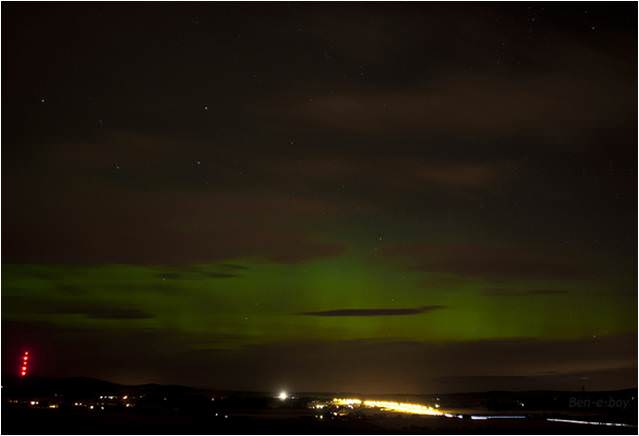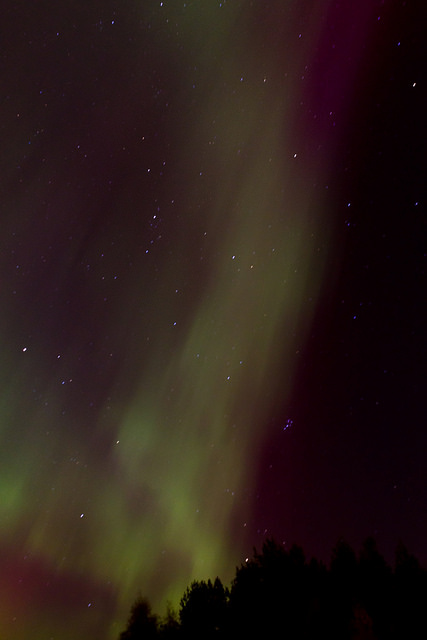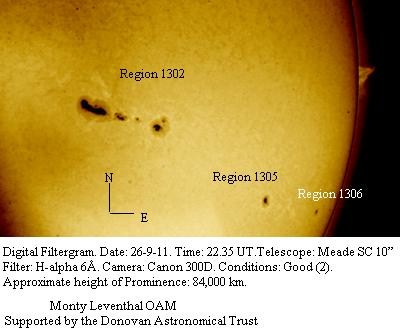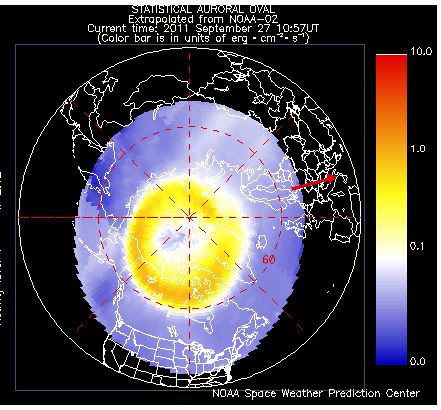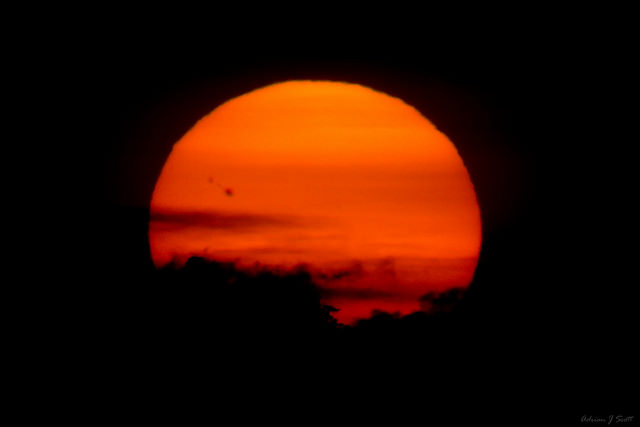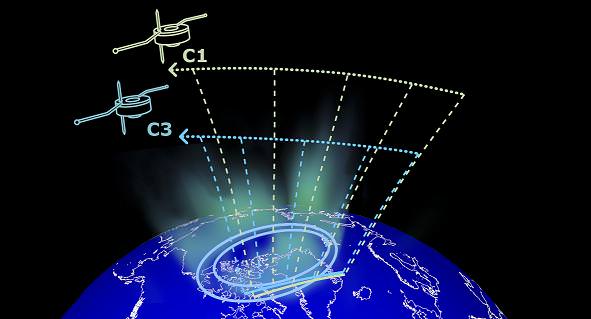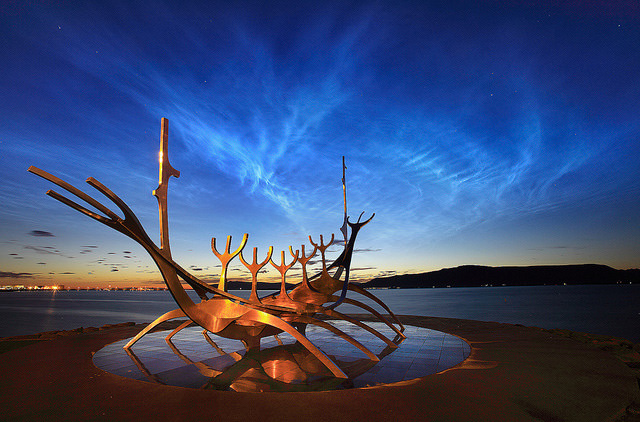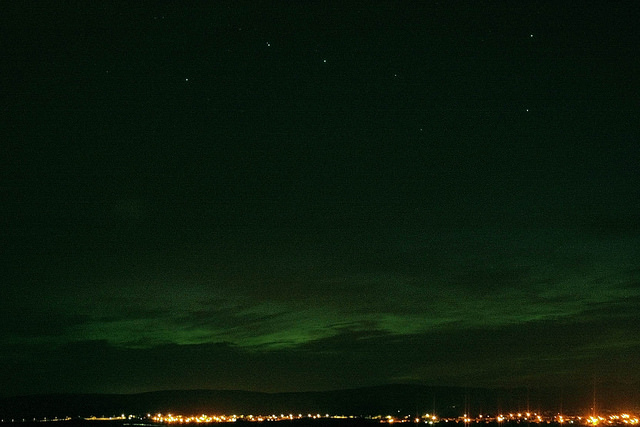This timelapse is a selection of northern lights filmed by Flatlight Films during the winter of 2011 in several locations in the Finnish Lapland. Sit back and enjoy from the warmth of your home or office!
Red Alert! Space Station Aurora
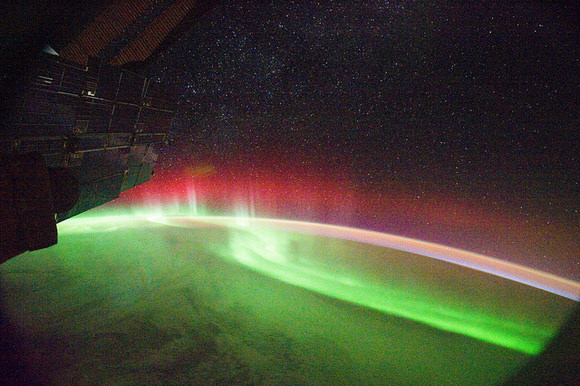
Astronauts had this view of the aurora on September 26, 2011. Credit: NASA
We’ve had some great views of the aurora submitted by readers this week, but this one taken from the International Space Station especially highlights the red color seen by many Earth-bound skywatchers, too. Karen Fox from the Goddard Space Flight Center says the colors of the aurora depend on which atoms are being excited by the solar storm. In most cases, the light comes when a charged particle sweeps in from the solar wind and collides with an oxygen atom in Earth’s atmosphere. This produces a green photon, so most aurora appear green. However, lower-energy oxygen collisions as well as collisions with nitrogen atoms can produce red photons — so sometimes aurora also show a red band as seen here.
An Easy Guide To Observing the Aurora
[/caption]
With the recent solar activity and the high possibility of more coming up, here is an easy guide to observing the aurora. An aurora is a natural light display high in the Earth’s atmosphere, caused by energetic particles from the Sun, colliding with the Earth’s magnetic field.
These light displays are called the Aurora Borealis in the Northern hemisphere and Aurora Australis in the Southern hemisphere, but are commonly known as the Northern and Southern lights.
Viewing aurorae is incredibly simple, but the conditions need to be right for a display to appear.
Normally you can only see aurorae near the poles, such as in Canada, Iceland, and Norway or southern Australia and Antarctica, but when the Sun is highly active, more solar material is thrown in Earth’s direction, creating powerful geomagnetic storms. These storms can bring auroral displays further south to areas such as Southern UK and North to mid latitudes of the USA.
The intensity scale is known as the Planetary KP index and basically the higher the KP number the further south Aurorae can be seen, KP 8 or higher can be good for observers further south. To find out what current levels are check spaceweather.com or the Geophysical Institute at the University of Alaska Fairbanks
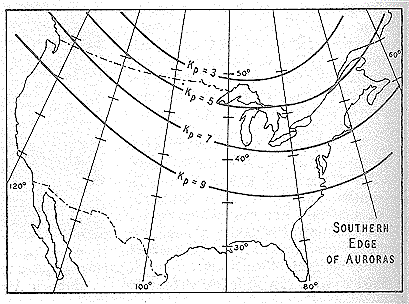
If aurora activity is predicted to be high and there is a possibility of seeing it at your location, try and find an area away from light pollution or bright lights and let your eyes adjust to the dark. This may require you to travel into the countryside to escape bright city light pollution.
The best time to spot aurora is around local midnight, but this can change depending on viewing conditions and the current intensity of the magnetic storm.
Once you are comfortable and your eyes have adjusted to the dark, face north (or south in the Southern Hemisphere).
You do not need binoculars, a telescope, or any other optical aid other than glasses if you wear them.
Look low and close to the horizon and look for the faint green/ reddish glow of aurora. It may be quite difficult to see at first, but if it is a powerful display it can be very easy to spot.
I live in the South of the UK and have seen the waving bands and curtain like structures quite easily in powerful geomagnetic storms.
If you have a camera that takes long exposures, use a tripod and try to image the aurora and send us your results.
Most of all, enjoy the show! Good luck!
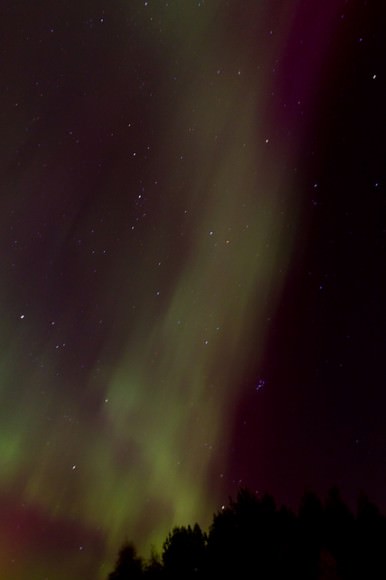
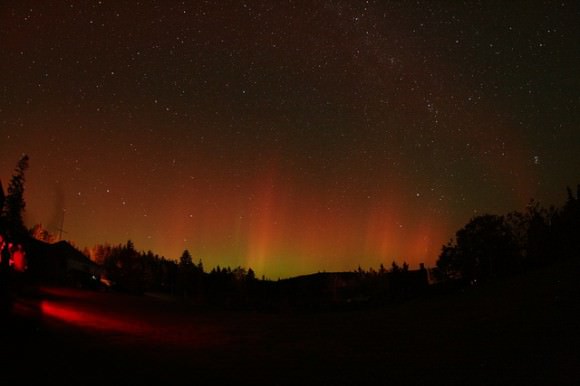
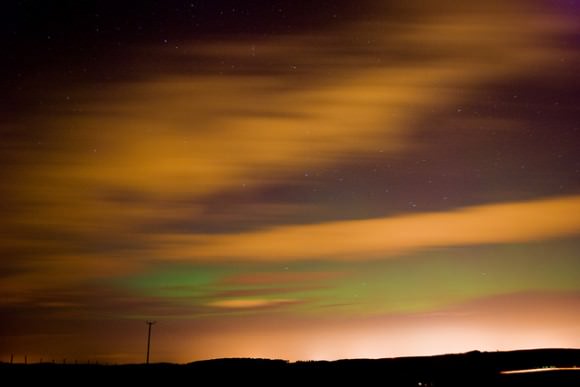
Active Sun, Beautiful Aurora: Reader Photos
[/caption]
Readers have submitted some great images of aurorae taken last night (Sept. 26 or early morning of Sept. 27). Why all the auroral activity? Sunspot region 1302 is big and bad, spewing out some nasty stuff. NASA says the sunspot’s magnetic field is currently crackling with sub-X-class flares that could grow into larger eruptions as the sunspot continues to turn toward Earth.
Here are some reader photos of the sunspot and the aurorae it created. A stunning view from Karstad Sweden, from Flickr user Socrates 2013, is above.
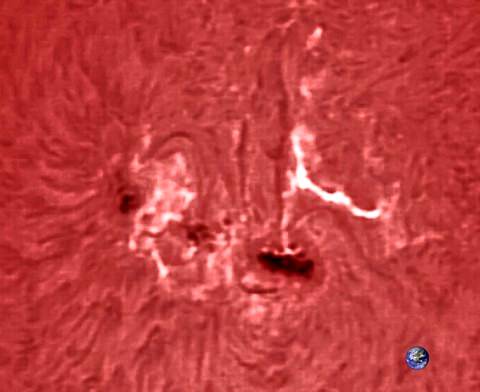
This massive sunspot region has already produced two X-flares (X1.4 on Sept. 22nd and X1.9 on Sept. 24th). The dark cores in the sunspots this image from reader Ron Cottrell is larger than Earth, (see inserted Earth for reference) and the entire active region stretches more than 100,000 km from end to end.
“Even with a small aperture, 40mm, Hydrogen – Alpha telescope the image details are amazing,” Cottrell emailed us. “I captured this image from my patio in Oro Valley, Arizona.” He used a webcam to do some image post processing.
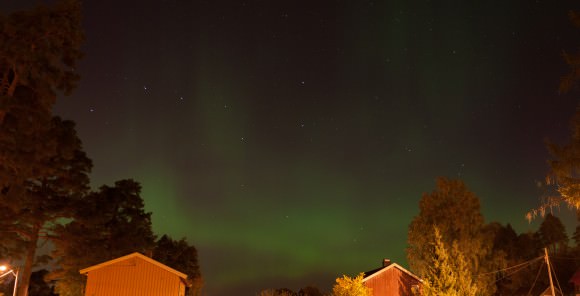
Kjetil Vinorum sent us some aurora photos from Porsgrunn, Norway (59° 09′ 33.3″N, 9° 39′ 46.9″E) and says this is the first time he’s seen aurora so far south in a decade.
This all-sky time-lapse of the aurora on Sept. 26-27, 2011 is from Arne Danielsen of Vestby, Norway (N59°36’18” E10°45’40” A84m).
The video shows a total of 726 images, which were obtained from Sunset to Sunrise. North is up and West is right. Be patient to see the aurora! Via Cosmos4U on Twitter
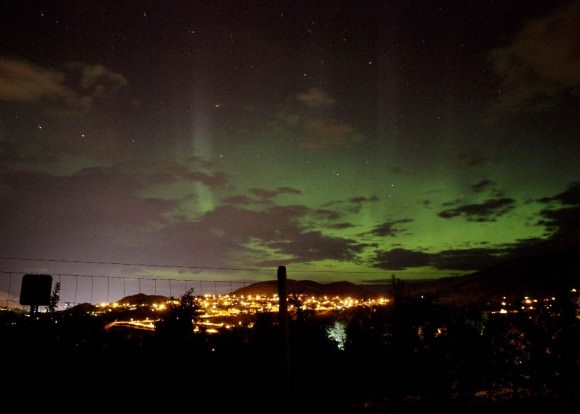
This beautiful shot was taken on the evening of September 27, 2011 by Marcel in British Columbia, Canada. The view is overlooking an orchard in the Coldstream Municipality.
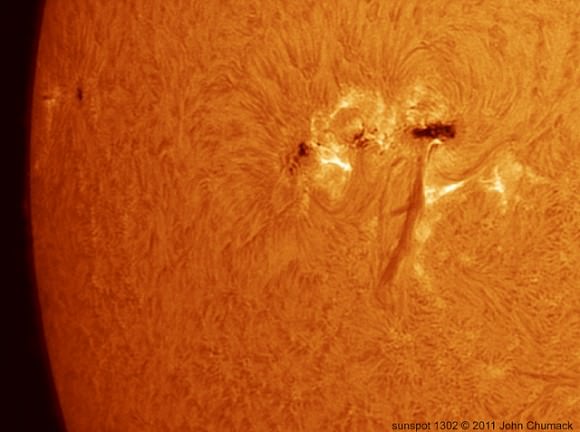
Here’s another view of the active region 1302 from John Chumack of Galactic Images.
The region has unleashed M8.6 and M7.4 flares on Sept. 24 and an M8.8 flare early on Sept. 25. None of the blasts have been squarely Earth-directed, but this could change, NASA says, as the sunspot turns toward our planet in the days ahead. AR1302 is growing and shows no immediate signs of quieting down.
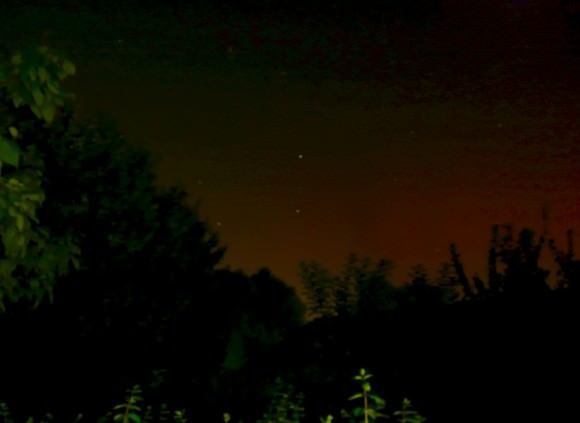
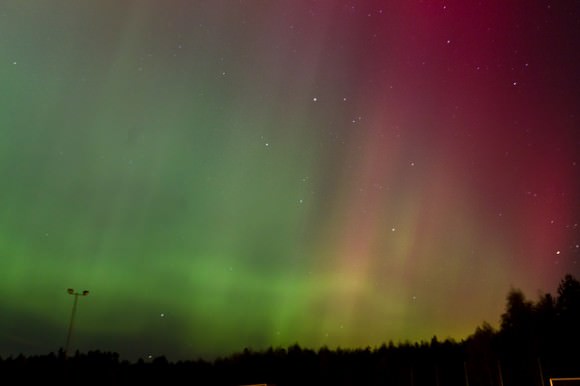
This image from Monty Leventhal shows the sunspots in region 1302 spreading across the face of the Sun for approximately 186,000 km. He used a Canon 300D with an Hydrogen-alpha filter with a Meade S.C. 10 inch telescope.
Aurora Alert for September 26 and 27!
[/caption]
Skywatchers in northern Europe are already seeing some aurora activity as a strong-to-severe geomagnetic storm is in progress, according to the NOAA Space Weather Prediction Center and SpaceWeather.com. The fuel for this storm was a coronal mass ejection over the weekend that has now reached Earth. This is great news for skywatchers, as both the Northern and Southern lights should be spectacular. But this is not so good news for satellite companies. The Goddard Space Weather Lab reports a “strong compression of Earth’s magnetosphere. Simulations indicate that solar wind plasma [has penetrated] close to geosynchronous orbit starting at 13:00 UT.” Geosynchronous satellites could therefore be directly exposed to solar wind plasma and magnetic fields.

The active region on the Sun will be pointed straight at Earth in few days as the Sun rotates, so this could be a week of high auroral activity. If you are able to capture images, send the to Universe Today via email or upload them to our Flickr page, and we’ll share them! See an image below of the Sun from September 25, 2011, showing the Active Region 1302, courtesy of John Chumack.
For more information and updates see the links above, or the Geophysical Institute at the University of Alaska Fairbanks.
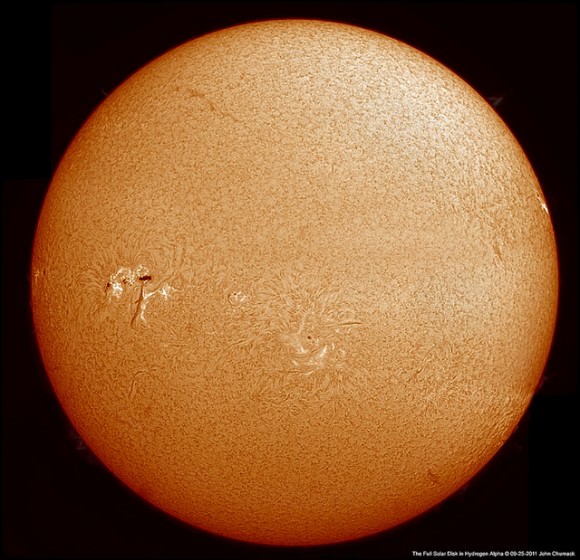
Massive Sunspot 1302
[/caption]
A highly active region on the Sun threatens to deliver powerful geomagnetic storms over the week ahead. Highly energetic solar eruptions are likely heading in our direction to give Earth’s magnetic field a significant glancing blow!
Over the past few days the new sunspot AR1302 has been incredibly active, hurling massive X-class solar flares into space and it will soon face Earth.
The massive sunspot, many times larger than the Earth (see images below) is expected to increase in size and energy, and is expected to release powerful solar flares, sparking strong geomagnetic storms.
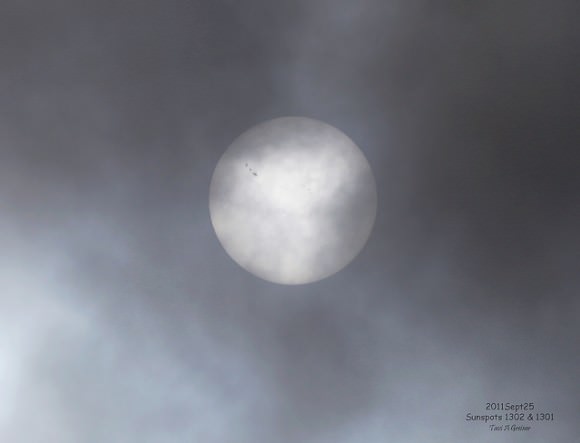
What does this mean for the Earth and it inhabitants?
The Earth experiences material ejected from the Sun on a daily basis and we are protected by the Earth’s own magnetic field. This is normal and has been happening since the birth of the solar system. But occasionally the Sun erupts and sends vast quantities of solar material our direction in the form of Coronal Mass Ejections (CME’s).
This can trigger very powerful geomagnetic storms, which can damage satellites in orbit and cause problems for communications and power networks. One positive outcome, though, is amazing displays of aurorae at the poles (Northern and Southern Lights).
Sunspot 1302 is expected to eject material towards Earth over the next few days, so look for news of strong geomagnetic activity and displays of aurorae.
Several observers are reporting that AR1302 is easily visible on the Sun at sunset or sunrise. Never ever look at the sun with your eyes, or any other optical aid! This will damage your eyesight permanently! The Sun should only be viewed using specialist equipment.
For further updates see Spaceweather.com and NASA’ Heliophysics Science Division

Exploring Geomagnetic Substorms
[/caption]
Every now and again, a sudden pulse of energy in Earth’s magnetosphere just cuts loose. As a result, we have a bright polar auroral display. While we’re beginning to understand more about magnetism and the Sun/Earth connection, there’s still a few rogues left in the gallery. Just what is a geomagnetic substorm and what does it do?
Although we’ve known about them for years, the exact process behind a geomagnetic substorm has been a mystery… one that’s being solved with data from missions like ESA’s Cluster spacecraft. Earth is continually being bathed in incoming sheets of electrons and protons – the product of an active Sun. These highly energized particles are simply a part of solar winds flowing from coronal holes and even powerful blasts from events like coronal mass ejections. For the most part, we’re shielded by the magnetosphere – but sometimes a wee bit escapes and collects in the magnetotail – stored like a battery charge. At a point, it’s released… and when it does, it re-arranges our magnetic field lines. The energy then conducts itself along these lines like a filament in a light bulb. When the watts hit the fan? Wow… We have polar aurora!
It’s not a new concept, but there’s never been a clear understanding of where these geomagnetic storms originate. Do they come from a sudden disruption of electric current about 64 000 km from the planet? Or are the created by a process called magnetic reconnection which occurs much further down the magnetotail, at a distance of around 125 000 – 200 000 km? If you remember our recent study of Alfven waves, then you know current consensus points towards the reconnection theory. But there’s only one problem. Alfven waves are slow movers, traveling at a reconnection speed of about 250 seconds. What we’re seeing is an event that occurs about 60 seconds after reconnection… and the birth of a new movement. The kinetic Alfven wave (KAW).
“We ran a very simple system, and simulated how the reconnection event released energy in the plasma sheet of charged particles,” said Shay. “We were looking for a faster mechanism for propagating the signal from the explosion than the Alfven waves that were already widely recognized.”
Unlike its predecessor which motivates both ions and electrons, the KAW only excites the electron, moving them through the plasma at twice the speed. Through simulations, it’s been proved the kinetic Alfven wave could be spawned by reconnection, move away from the explosion and activate aurora. The data was returned by the Fluxgate Magnetometer (FGM) and the Electric Fields and Waves (EFW) instrument and found by Jonathan Eastwood, a Research Fellow at The Blackett Laboratory, Imperial College London.
“I found 18 events which occurred at the time the four spacecraft were flying through the tail region,” said Dr. Eastwood. “The fast signal predicted by Michael Shay showed up in the Cluster data, supporting the theory that kinetic Alfven waves generated by reconnection were rapidly energizing the auroras.”
“It’s rather like what happens in a thunderstorm,” he added. “The fast-moving lightning flash arrives first, followed some time later by the slower sound waves of the thunderclap.”
Fancy that… Coming from a substorm!
Original Story Source: ESA Science and Technology News. For Further Reading: Super-Alfvenic Propagation of Substorm Reconnection Signatures and Poynting Flux.
A Noctilucent Masterpiece
[/caption]
Night-shining “noctilucent” clouds create a magical glow in the night skies over Reykjavíc, Iceland in this beautiful photo by Örvar Atli Þorgeirsson, taken on August 6. In the foreground is “The Sun Voyager” (Sólfar), an iconic steel sculpture located on the city waterfront representing a Viking ship.
Örvar did not set out to photograph this rare atmospheric phenomenon but had instead intended to shoot aurora triggered by recent solar outbursts.
“The forecast on the 6th of August was predicting extreme aurora activity,” Örvar says in his Flickr description. “Even though it was very early August and the night would not get fully dark I went out as the aurora can be seen in deep twilight conditions. I saw the aurora for 1 – 2 minutes that night. I did not get a good picture of it though. Instead we witnessed this even rarer phenomenon called noctilucent clouds.”
Noctilucent clouds are extremely high-level clouds made located in the mesosphere, around 76 to 85 kilometers (47 to 53 miles) high… nearly at the very edge of space. (Most commercial airplanes fly between 6 and 7 miles high.) They are high enough to reflect sunlight coming from beyond the horizon long after night has fallen over the land below. They usually appear as a wispy web of blue, white, purple and orange tendrils stretched across the sky.
“These clouds where extremely beautiful to look at and reminded me of the aurora but where much more stationary and had this beautiful blue color.”
– Örvar Atli Þorgeirsson
Noctilucent clouds are mainly visible at latitudes between 50º – 70º north and south during the months of June and July. This means Reykjavíc, located right in the middle, can get great views. (Of course it helps to have a talented photographer like Örvar to capture them so nicely!)
Oddly enough noctilucent clouds are a relatively recent phenomenon, only having been recorded for about 120 years. They have been connected with space shuttle passages through the upper atmosphere, and it’s even been suggested that they may be associated with the 1908 Tunguska impact.
Read more about noctilucent clouds here.
Image © Örvar Atli Þorgeirsson. All rights reserved. Used with permission.
_____________________
Jason Major is a graphic designer, photo enthusiast and space blogger. Visit his website Lights in the Dark and follow him on Twitter @JPMajor or on Facebook for the most up-to-date astronomy news and images!
Recent Active Sun Prompts Stunning Auroras Over England
[/caption]
On the evening of the 5th of August 2011 the Aurora Borealis, Northern Lights were seen as far South as Southern England! At approximately 18:00 Universal Time (19:00 BST) the Earth’s magnetosphere was hit by a coronal mass ejection from the sun, triggering a powerful geomagnetic storm and Aurora.
This storm measured 8 on the K index (aurora richter scale) which ranges from 0 – 9 so this was a big storm.
It is quite common to see Aurora in Northern Scotland, but at approximately midnight, aurora was seen as far south as Berkshire, Wiltshire and Hampshire in Southern England. It is incredibly rare to see aurora this far south — the last time I remember was in 2003.
I was incredibly lucky to briefly see the pale greenish hue of the aurora through clouds from my back garden in West Berkshire.
Unfortunately a lot of people in England and Scotland were under thick cloud and missed this fantastic display, but thanks to fantastic astrophotographers such as Raymond Gilchrist (@RayGil on twitter) we are able to see the aurora through his images.
Did you see any aurora activity in your location? Geomagnetic activity remains high as I write this article, so I hope the sky clears and we are given another fantastic display of this rare phenomenon soon.
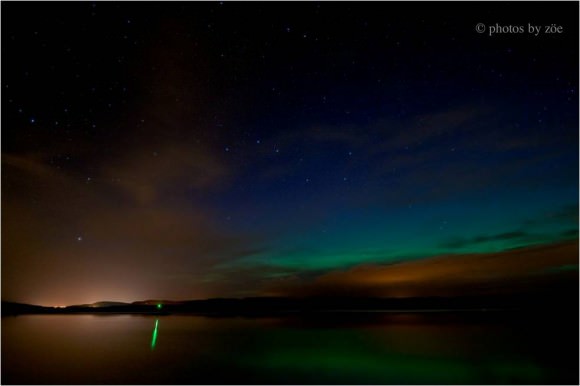
Exoplanet Aurora… Light ‘Em Up!
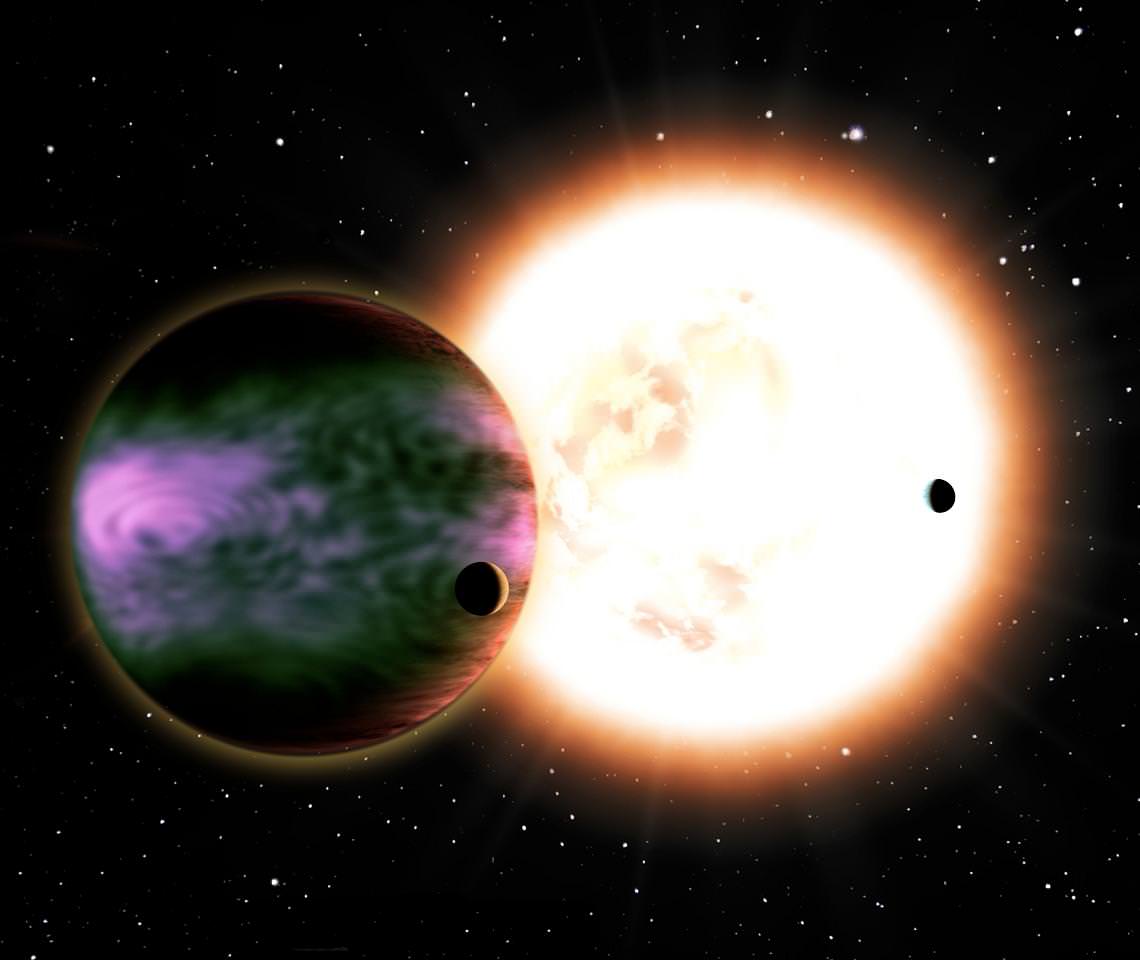
[/caption]
One of the most beautiful and mysterious apparitions – be it north or south – here on Earth is an auroral display. We know it’s caused by the Sun-Earth connection, so could it happen around exoplanets as well? New research shows that aurorae on distant “hot Jupiters” could be 100-1000 times brighter than Earthly aurorae, creating a show that would be… otherworldly!
“I’d love to get a reservation on a tour to see these aurorae!” said lead author Ofer Cohen, a SHINE-NSF postdoctoral fellow at the Harvard-Smithsonian Center for Astrophysics (CfA).
As we are now aware, aurorae occur here on Earth when the Sun’s energetic particles encounter our magnetosphere and are shifted towards the poles. This in turn excites the atmosphere, ionizing the particles. Much like turning on your electric stove, this causes the “element” to glow in visible light. It happens here… and it happens on Jupiter and Saturn as well. If other suns behave like our own and other planets have similar properties to those in our solar system, then the answer is clear.
Exoplanets have aurorae, too.
Cohen and his colleagues used computer models to study what would happen if a gas giant in a close orbit, just a few million miles from its star, were hit by a stellar blast. He wanted to learn the effect on the exoplanet’s atmosphere and surrounding magnetosphere. In this scenario, the solar storm is much more focused and far more concentrated when it impacts a “hot Jupiter”. In our solar system, a coronal mass ejection spreads out before it reaches us, but what would happen if it collided with a nearer planet?
“The impact to the exoplanet would be completely different than what we see in our solar system, and much more violent,” said co-author Vinay Kashyap of CfA.
Using modeling, the team took a look at the scenario. The solar blast would slice into the exoplanet’s atmosphere and weaken its magnetic shield. The auroral activity would then form a ring around the equator, 100-1000 times more energetic than seen here on Earth. It would then travel up and down the planet’s surface from pole to pole for hours, gradually weakening – yet the planet’s magnetosphere would save it from erosion. This type of study is important for understating habitable properties of Earth-like worlds.
“Our calculations show how well the planet’s protective mechanism works,” explained Cohen. “Even a planet with a magnetic field much weaker than Jupiter’s would stay relatively safe.”
Original News Source: Harvard-Smithsonian Center for Astrophysics News.

